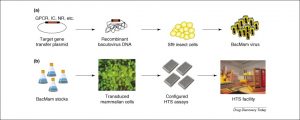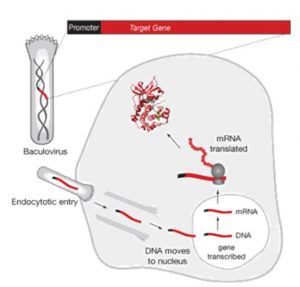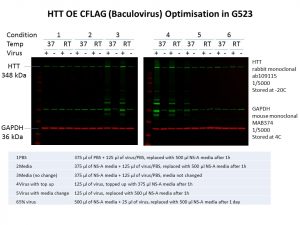The experimental set-up and results covered in this post can be found here: 10.5281/zenodo.1172644
One of the main aims of my project is to understand the role of normal and mutant HTT in mammalian cells. To do so, I will be overexpressing HTT in mammalian cells using baculovirus.
The use of baculovirus for protein expression in mammalian cells is not new, but it has become more widely used over the years. This technique is termed BacMam. You can read up more on this technology in this review which gives a good overview of the advances and improvements in the use of baculoviruses:
Baculovirus as versatile vectors for protein expression in insect and mammalian cells.
Kost TA, Condreay JP, Jarvis DL.
Nat Biotechnol. 2005 May;23(5):567-75. DOI: 10.1038/nbt1095
Briefly, the DNA of the baculovirus is modified to include the gene of interest. In our case, this will be HTT. Baculovirus containing the modified DNA is typically produced using Sf9 insect cells, which packages the modified DNA into fully formed baculoviruses and releases them into the cell media. These baculoviruses can be concentrated by centrifugation and used directly to infect mammalian cells, allowing the gene of interest to be produced in the mammalian cells.

Image source: https://ars.els-cdn.com/content/image/1-s2.0-S1359644607001006-gr1.jpg from Fig 1 of the following article.
Implementation of BacMam virus gene delivery technology in a drug discovery setting.
Kost TA, Condreay JP, Ames RS, Rees S, Romanos MA.
Drug Discov Today. 2007 May;12(9-10):396-403. Epub 2007 Mar 23. DOI: 10.1016/j.drudis.2007.02.017

Image source: http://www.thermofisher.com/content/dam/LifeTech/migration/images/drug-discovery-development/data.par.0356.image.420.382.1.dat-s006918-bacmam-gif.gif from Fig 1 of ThermoFisher Scientific’s BacMam Technology Overview, which gives a more detailed workflow of BacMam production here: http://www.thermofisher.com/ca/en/home/industrial/pharma-biopharma/drug-discovery-development/target-and-lead-identification-and-validation/pathway-biology/cellular-pathway-analysis/bacmam-system/bacmam-technology-overview.html
The HTT baculovirus that I will be using was developed here at SGC Toronto by Rachel Harding, Peter Loppnau and Alma Seitova, who designed, cloned and produced the HTT baculovirus. As I have not used baculoviruses before, I started out by scouring the literature on how baculovirus transduction in mammalian cells is done. One very comprehensive paper I found was this:
Investigation of optimal transduction conditions for baculovirus-mediated gene delivery into mammalian cells.
Hsu CS, Ho YC, Wang KC, Hu YC.
Biotechnol Bioeng. 2004 Oct 5;88(1):42-51. DOI: 10.1002/bit.20213
According to this paper, these are the main factors that affect transduction efficiency into mammalian cells (HeLa cells were used in this paper).
- Virus dosage – increasing amounts of virus will improve transduction efficiency
- Incubation time – increasing incubation time with virus will improve transduction efficiency
- Incubation temperature – transduction occurs better at room temperature (25˚C) rather than at 37˚C due to a decrease in virus titre at higher temperatures.
- Surrounding solution (cell media) – D-PBS resulted in better transduction efficiency compared to the other media tested, which included DMEM
- Cations – The presence of cations such as Ca2+ and Mg2+ did not significantly affect transduction efficiency
I also found this paper:
Improving promiscuous mammalian cell entry by the baculovirus Autographa californica multiple nuclear polyhedrosis virus.
O’Flynn NM, Patel A, Kadlec J, Jones IM.
Biosci Rep. 2012 Nov 30;33(1):23-36. DOI: 10.1042/BSR20120093
Following up on point 5 on cations from the previous paper, a common cation added to aid virus entry into cells is polybrene. However, this paper shows that the addition of polybrene for baculovirus entry actually impairs transduction efficiency.
With these factors in mind, I set out to optimise the conditions for baculovirus transduction in my cells.
In short, I tested the following six conditions in two 24-well plates, one of which was incubated at 37˚C throughout while the other was kept at room temperature for 1h immediately following addition of baculovirus, then incubated at 37˚C:
- 375 µl of PBS + 125 µl of virus/PBS, replaced with 500 µl NS-A media after 1h
- 375 µl of NS-A media + 125 µl of virus/PBS, replaced with 500 µl NS-A media after 1h
- 375 µl of NS-A media + 125 µl of virus/PBS, media not changed
- 125 µl of virus, topped up with 375 µl NS-A media after 1h
- 125 µl of virus, replaced with 500 µl NS-A media after 1h
- 500 µl of NS-A media + 25 µl of virus, replaced with 500 µl NS-A media after 1 day
For each condition, a control where the same volume of PBS was added in place of baculovirus was included.
Cells were harvested for protein 3 days post-transduction. Western blot was used to assess the levels of HTT present in the cells under the different conditions. You can find my full experimental set-up, the Western blot images and quantification (normalised to GAPDH and the respective PBS controls) here: http://doi.org/10.5281/zenodo.1167896
The clear winners are conditions 3 and 4!
- 375 µl of NS-A media + 125 µl of virus/PBS, media not changed
- 125 µl of virus, topped up with 375 µl NS-A media after 1h

It appears that the greatest factor contributing to increased HTT expression is the duration at which the cells are exposed to the virus. Conditions in which the cell medium was replaced with fresh medium not containing any baculovirus had the lowest levels of HTT (conditions 1, 2, 5 and 6). Between the plate incubated at 37˚C throughout and the plate kept at room temperature for 1h, there was almost no difference in HTT levels across the different conditions. In fact, by looking at the Western blot image, transduction using condition 4 at 37˚C seems to be better than at room temperature. This might be due to the cells themselves being happier at 37˚C although the viruses may fare better at lower temperatures.
Subsequent experiments will be carried out using conditions 3 and/or 4.

Hi,
I am from Australia, we are also interested in using the BacMam system, we will be using CHO cells, was wondering if you could share a detailed protocol for the transfection and transduction.
Regards,
A